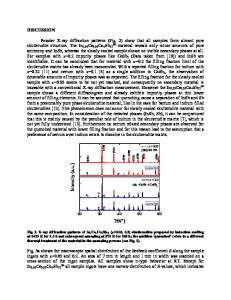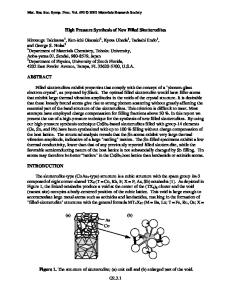High Temperature Electrical Transport Properties of Eu and Yb-doped Skutterudites
- PDF / 214,950 Bytes
- 6 Pages / 612 x 792 pts (letter) Page_size
- 108 Downloads / 333 Views
High Temperature Electrical Transport Properties of Eu and Yb-doped Skutterudites R. H. Tedstrom, G. A. Lamberton, Jr., Terry M. Tritt, Dept of Physics and Astronomy, Clemson Univ., Clemson, SC USA; G. S. Nolas, Dept of Physics University of Southern Florida, Tampa, FL USA. Abstract: Skutterudites are a class of materials that show promise for thermoelectric applications due to their high power factor and the ability to “tune” the thermal conductivity due to the addition of “rattling” atoms into the novel structure of these materials. Thermopower and resistivity is measured and reported for a series of Eu and Yb-doped skutterudites over a temperature range of approximately 100 K – 700 K using the High Temperature Thermoelectric Probe. Sample measurement techniques are briefly discussed. Data from various dopings is presented and compared in hope of showing trends that point towards improvements in these skutterudites. Introduction: Skutterudites are materials with the chemical formula MPn3 where M is a transition metal (Co, Rh, Ir) and Pn is a pnicogen (P, Sb, As). The name “skutterudite” comes from the name of the town in which the original skutterudite material, CoAs3, is found, Skutterude, Norway. Skutterudites exhibit electrical and thermal transport properties that show promise as a high temperature thermoelectric material. A figure of merit, ZT ~ 1.2 - 1.4 at 900 K was reported by Fleurial et. al. [1] and Sales et. al. reported a ZT of ~ 0.7 at 800 K [2] in CeyFe4-xCoxSb12 compounds. The figure of merit, ZT is given by ZT = α2T/ρκ where: α is the thermopower, ρ is the electrical resistivity and κ is the total thermal conductivity. In Yb0.19Co4Sb12, Nolas et. al. reported a ZT ~ 1 near 600 K. [3] Skutterudites conform closely to the model proposed by Slack of the “phonon-glass, electron-crystal.” They have a large unit cell, heavy constituent atoms, and large carrier mobilities. Skutterudites unfortunately also possess high thermal conductivity. The parent material, CoSb3, has a thermal conductivity of ~ 8.5 Wm-1K-1 at 300 K. [4] However, the substitution of atoms in the void spaces was shown to reduce the thermal conductivity by Morelli and Meisner.[5] More recently, Nolas et. al. [6] has shown that reduced thermal conductivity can be obtained by void filling with rare-earth lanthanides. In this paper, investigations of the effect of charge compensation using Ge substitution at the Sb site in a series of REXCo4GeYSb12-Y skutterudites with rare earth atoms (RE = Yb or Eu) inserted in the interstitial sites as caged rattlers are reported. It is the hope of this work to determine the optimum carrier concentration in order to maximize the power factor, PF = α2T/ρ, as proposed by Ioffe. [7] Therefore, we are primarily interested in the effect of the Ge
G8.10.1
substitutions on the thermopower and resistivity over a broad range of temperature, especially at T > 300 K which is the focus of this work. Experimental Method: Thermopower and resistivity measurements were made with a second-generation High Temperature T
Data Loading...











